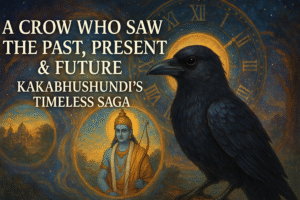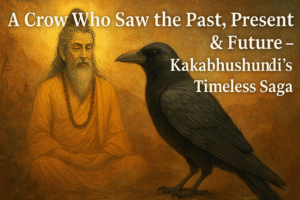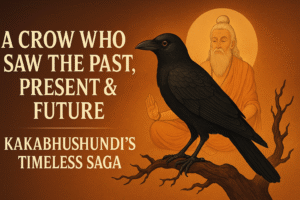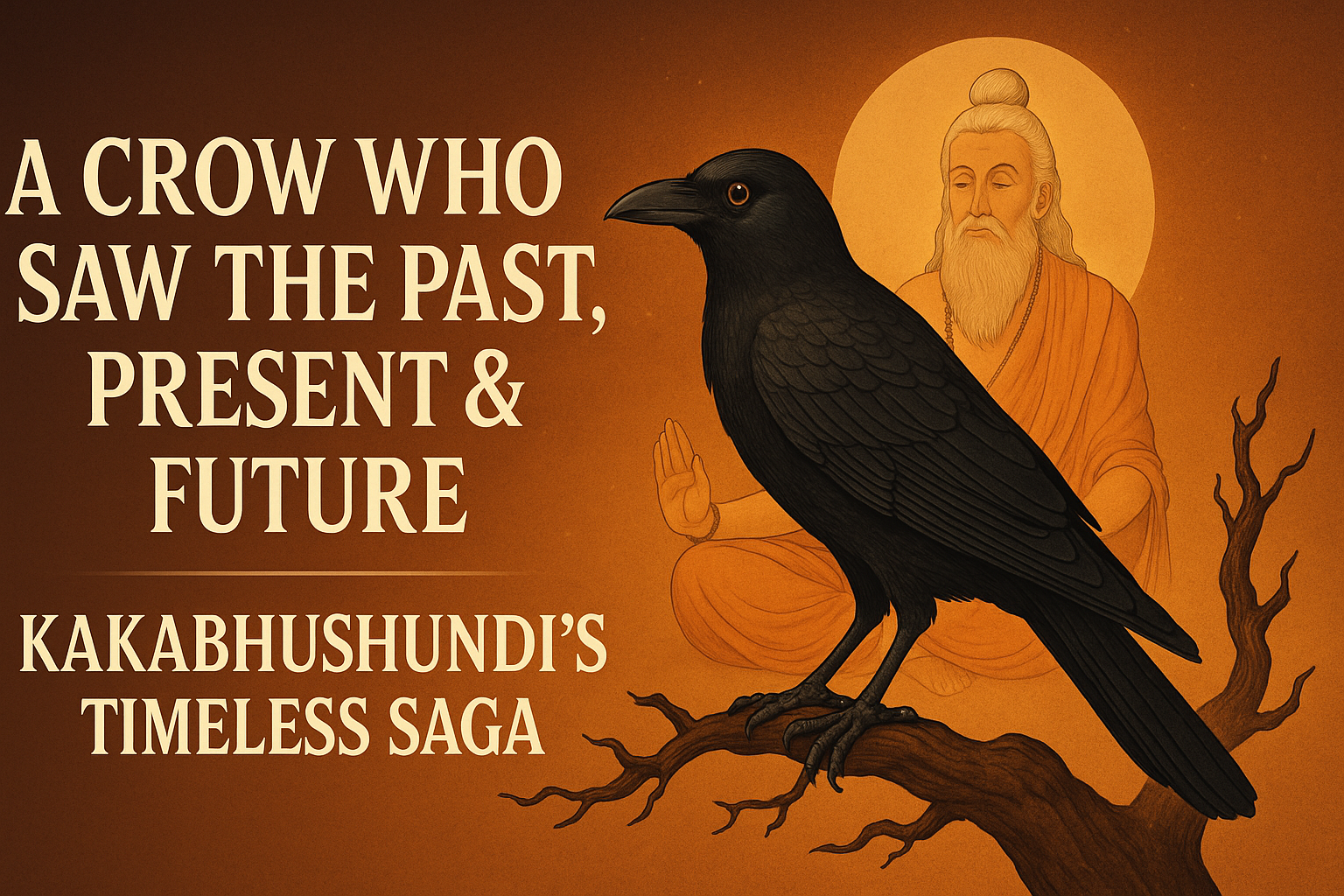
A Crow Who Saw the Past
Sage Kakabhushundi – The Bird Who Witnessed All Yugas
Sage Kakabhushundi, a revered figure in Hindu mythology, is one of the most fascinating and mysterious characters mentioned in ancient scriptures. Unlike most sages who appear in human form, Kakabhushundi chose the form of a crow—an immortal witness to the cosmic drama of countless Yugas (epochs). His life, devotion, and wisdom have made him a timeless symbol of unwavering bhakti (devotion) and eternal knowledge.
Who is Sage Kakabhushundi?
Kakabhushundi is a saint who is said to have attained immortality through intense devotion to Lord Rama. According to the Ramcharitmanas by Goswami Tulsidas, he narrates the story of Lord Rama to Garuda, the divine vehicle of Lord Vishnu. What makes this sage unique is his crow form, which he chose after attaining spiritual realization, enabling him to fly across time and space to witness the unfolding of divine events across all four Yugas – Satya Yuga, Treta Yuga, Dvapara Yuga, and Kali Yuga.
The Story Behind His Crow Form
Originally, Kakabhushundi was a Brahmin with immense ego and pride in his knowledge. He disrespected Lord Shiva and mocked devotion towards Lord Rama. As a result, he was cursed to become a crow, a bird often associated with inauspiciousness. However, through penance and Shiva’s grace, the curse turned into a blessing. In his crow form, he achieved jnana (wisdom) and bhakti, eventually becoming one of the greatest devotees of Lord Rama.
Witness to All Yugas
Sage Kakabhushundi is considered one of the Chiranjivis—immortal beings who live through all ages. His existence stretches across cosmic cycles, allowing him to witness events like the Ramayana, Mahabharata, and even events in Kali Yuga. His detailed narration of these events to Garuda is not just a retelling but an eye-witness account filled with spiritual insights.

Table of Contents
The Conversation with Garuda
In many versions of Puranic literature, Kakabhushundi shares profound conversations with Garuda. These dialogues cover deep spiritual philosophies, the nature of karma, devotion, maya (illusion), and moksha (liberation). His storytelling is rich with love for Lord Rama and compassion for all beings.
One of his most quoted lines in Ramcharitmanas:
“Rama bhagati jinha ke man mahi, te nar prabhuhin bhāva nahin pāhi.”
“Those who have devotion to Rama in their hearts, they alone are dear to the Lord.”
Symbol of Devotion and Humility
Kakabhushundi represents the transformation from ego to humility, from knowledge to wisdom, and from arrogance to surrender. By choosing the humble form of a crow, he teaches us that external appearance means nothing in the path of devotion—what matters is the purity of heart.
Why Sage Kakabhushundi Matters Today
In today’s chaotic world, the teachings of Kakabhushundi hold immense value:
Timeless Wisdom: His knowledge transcends time, offering deep spiritual truths relevant even in the modern age.
Faith Beyond Form: His story reminds us that true devotion is beyond caste, creed, or form.
Hope in Kali Yuga: As a living witness of all Yugas, Kakabhushundi serves as a beacon of hope in Kali Yuga, guiding seekers toward light.
Conclusion
Sage Kakabhushundi is not just a mythological figure but a spiritual symbol of eternal devotion, transformation, and divine wisdom. His life and teachings inspire millions to rise above ego, embrace humility, and walk the path of bhakti. Whether you see him as a divine crow or a realized sage, one thing remains certain—his devotion to Lord Rama is immortal, and so is his wisdom.

FAQs (Frequently Asked Questions) on Sage Kakabhushundi – The Bird Who Witnessed All Yugas:
- Who is Sage Kakabhushundi?
Answer: Sage Kakabhushundi is an immortal devotee of Lord Rama who took the form of a crow and witnessed events across all four Yugas—Satya, Treta, Dvapara, and Kali. He is known for narrating the Ramayana to Garuda, the vehicle of Lord Vishnu.
- Why did Kakabhushundi take the form of a crow?
Answer: He was cursed to become a crow due to his arrogance and disrespect toward Lord Shiva. However, after deep penance, the curse became a blessing. In crow form, he attained supreme knowledge and devotion to Lord Rama.
- What makes Kakabhushundi immortal?
Answer: Kakabhushundi is one of the Chiranjivis—immortal beings in Hindu tradition. His deep devotion and spiritual elevation earned him the boon of immortality, allowing him to live through all cosmic cycles (Yugas).
- What is the significance of Kakabhushundi in Hindu scriptures?
Answer: He plays a vital role in the Ramcharitmanas by Tulsidas, where he narrates Lord Rama’s life story to Garuda. His perspective is unique because he personally witnessed these divine events.
- What lesson does Kakabhushundi’s story teach us?
Answer: His life teaches the power of devotion (bhakti) over pride, the importance of humility, and that spiritual realization is open to all, regardless of form or birth.
- Did Kakabhushundi meet Lord Rama personally?
Answer: Yes, according to scriptures, he had direct darshan (sight) of Lord Rama during his lifetime. His devotion was so deep that he was spiritually connected to Rama even before meeting Him.
- What conversation did Kakabhushundi have with Garuda?
Answer: In their conversation, Kakabhushundi shared detailed spiritual wisdom, the story of Lord Rama, the nature of karma, life, and liberation. These are recorded in Puranic literature and are highly revered.
- Is Kakabhushundi mentioned in the Ramayana?
Answer: He is not directly mentioned in Valmiki Ramayana, but features prominently in Ramcharitmanas by Tulsidas and in several Puranas, where his devotion and wisdom are elaborated.
- What is the symbolism behind his crow form?
Answer: The crow symbolizes detachment, humility, and longevity. Despite being a humble and often misunderstood bird, the crow form reflects Kakabhushundi’s spiritual evolution and disregard for outer appearances.
- How is Kakabhushundi relevant in Kali Yuga?
Answer: In Kali Yuga, where spiritual values decline, Kakabhushundi remains a beacon of hope, reminding devotees that faith, devotion, and inner transformation are the true paths to liberation.
Summary
Sage Kakabhushundi is a unique and immortal devotee of Lord Rama, who took the form of a crow and witnessed the divine events of all four Yugas—Satya, Treta, Dvapara, and Kali. Once a proud Brahmin, he was cursed due to his arrogance but later transformed into a humble and wise sage through deep devotion. He is best known for narrating the Ramayana to Garuda, offering rare spiritual insights and firsthand accounts. Kakabhushundi’s story is a symbol of humility, transformation, and unwavering bhakti, proving that true devotion transcends form, caste, and ego. His timeless wisdom continues to inspire seekers, especially in today’s age of Kali Yuga.
Unlock the Ancient Wisdom of Sanatan Dharma – Join Us on YouTube!

Explore timeless teachings, spiritual insights, and cultural richness on our YouTube channel, Prachin Sanatan Dharma. Dive deep into the essence of Sanatan Dharma through captivating videos that inspire and educate.
Related Articles
- Restful Nights: Ayurvedic Remedies and Traditional Indian Practices to Overcome Insomnia and Late-Night Habits
- The Tridevi: Lakshmi, Saraswati, and Parvati – Their Roles and Powers
- “Divine Creatures of Ancient Indian Scriptures: Exploring the Role of Animals in the Vedas, Puranas, and Mahabharata”
- Nature and Spirituality: Exploring the Sacred Essence of the Himalayas, Ganga, and Other Natural Wonders”
- “Reviving the Gurukul System: Relevance and Lessons for Modern Education”
- “Exploring Greek and Indian Mythology: Similarities Between Greek and Indian Mythology “
- “Embracing Sattvic Living: Harmonizing Mind, Body, and Soul Through Food and Lifestyle”
- “Charity and Prosperity: Exploring the Concept of Daan and Its Financial Relevance in Modern Life”
- How to Build an Eco-Friendly Home Inspired by Vastu Shastra
- Comparison of Ancient and Modern Sports: How Traditional Sports Have Influenced Contemporary Games
- “Timeless Lessons from Ancient Tales: Linking Samudra Manthan and Ganga’s Descent to Modern Ecological Challenges”
- “Reviving Sanskrit: How AI is Preserving Ancient Languages for the Future”
- “Mathura: The Sacred Land of Lord Krishna’s Divine Leelas”
- Investing for Future Generations: Lessons from Indian Traditions on Legacy Building and Wealth Preservation
- “Ancient Indian Wisdom: Timeless Lessons for Tackling Today’s Climate Crisis”
- “Artificial Intelligence and Spirituality: Transforming Ancient Practices for the Modern World”
- “Gold and Real Estate in India: Timeless Assets Shaping Financial Strategies”
- Tradition Meets Innovation: The Evolution of Technology in Hindu Rituals
- End-of-World Myths: Exploring Kali Yuga in Hinduism and Ragnarök in Norse Mythology
- Garuda, Pegasus, and Dragons: The Universal Ties of Mythical Beasts Across Cultures
- “Ancient Vimanas: Mythical Flying Machines or Evidence of Advanced Technology?”
- Time Travel in Hindu Mythology: The Fascinating Tales of Kakudmi and King Raivata
- “Divine Feminine Power in Hindu Mythology: The Legends of Durga, Saraswati, and Lakshmi”
- “Divine Beings of Sanatan Dharma: The Spiritual Significance of Sacred Animals in Hinduism”
- “Symbolism in Mythological Art: Unlocking Hidden Meanings in Ancient Temple Carvings”
- “Exploring Technological Advancements in Ancient India and Civilizations: Vimana, Metallurgy, & Water Management systems”
- Unveiling the Mysteries: Ancient Temples of Sanatan Dharma , Mysterious Temples of India
- “The Scientific Knowledge of Sanatan Dharma: Ancient Wisdom Meets Modern Science”
- Ancient Indian Sports and Games: Celebrating a Legacy of Skill, Strength & Strategy”
- “Exploring the Cosmic Link: The Connection Between Astronomy and Vedic Astrology”
- The Power of Sanskrit: Unlocking the Divine Language of the Gods
- “The End of Kaliyuga: A Sanatan Insight into the World’s Final Chapter”
- Explore more articles on Prachin Sanatan Yuga.
A Crow Who Saw the Past, Present & Future – Kakabhushundi’s Timeless Saga A Crow Who Saw the Past, Present & Future – Kakabhushundi’s Timeless Saga A Crow Who Saw the Past, Present & Future – Kakabhushundi’s Timeless Saga A Crow Who Saw the Past, Present & Future – Kakabhushundi’s Timeless Saga A Crow Who Saw the Past, Present & Future – Kakabhushundi’s Timeless Saga
A Crow Who Saw the Past, Present & Future – Kakabhushundi’s Timeless Saga A Crow Who Saw the Past, Present & Future – Kakabhushundi’s Timeless Saga A Crow Who Saw the Past, Present & Future – Kakabhushundi’s Timeless Saga A Crow Who Saw the Past, Present & Future – Kakabhushundi’s Timeless Saga A Crow Who Saw the Past, Present & Future – Kakabhushundi’s Timeless Saga
A Crow Who Saw the Past, Present & Future – Kakabhushundi’s Timeless Saga A Crow Who Saw the Past, Present & Future – Kakabhushundi’s Timeless Saga A Crow Who Saw the Past, Present & Future – Kakabhushundi’s Timeless Saga A Crow Who Saw the Past, Present & Future – Kakabhushundi’s Timeless Saga A Crow Who Saw the Past, Present & Future – Kakabhushundi’s Timeless Saga
A Crow Who Saw the Past, Present & Future – Kakabhushundi’s Timeless Saga A Crow Who Saw the Past, Present & Future – Kakabhushundi’s Timeless Saga A Crow Who Saw the Past, Present & Future – Kakabhushundi’s Timeless Saga A Crow Who Saw the Past, Present & Future – Kakabhushundi’s Timeless Saga A Crow Who Saw the Past, Present & Future – Kakabhushundi’s Timeless Saga
